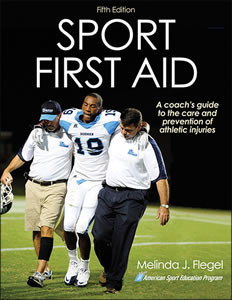MEDIA
REVIEW
This book includes three in-depth parts about the treatment
and prevention of athletic injuries. The first two chapters
are part one of the book and are about the role coaches' play
in the health of their athletes and in creating emergency
plans. The next four chapters comprise part two of the book
and are about understanding the body and how to administer
first aid. The final nine chapters form part three and are
about treating specific injuries to the body. Each chapter
ends with a review of the chapter that is called the "replay"
and recommended reading to further your knowledge.
Part One of the book goes into detail about who should be
included in the medical team for your athletes. The roles
that doctors play are discussed but also identified are individuals
you might not initially consider as involved in an athlete's
health. These include equipment managers and strength and
conditioning coaches. The book is careful to define the legal
definition of the coach's role and what is expected of them.
This part of the book is useful but I'd suggest that it is
also important to check the laws within your state and school.
This is not mentioned in the book. Part One also identifies
the proper medical forms that should be carried for each student-athlete.
The book provides examples in case your school does not have
a specific form to follow. Creating a weather safety checklist,
a faculties' checklist, and a first aid kit checklist is described.
As the coach you have the right to say you are not comfortable
with the weather conditions or playing conditions and having
a checklist will help you to make those decisions. These checklists
may also keep your players from getting hurt. Flegel's rule
is, when in doubt don't play it out.
Part Two of the book begins by explaining physical anatomy
including neurological, digestive, respiratory and circulatory,
and urinary systems. The anatomy of each system and how these
systems are used during play are explained. Excellent illustrations
accompany the explanations for visual learners. Common injuries
and what sports these injuries are prevalent in are discussed.
The next section describes basic emergency first aid in
case an athlete stops breathing. There are multiple illustrations
and charts that go along with the skills explained. Some of
the illustrations are drawn and some are real photos. The
photos get the point across clearer than those that are drawn
with a cartoonish quality. The last section of Part Two describes
how to splint or care for non-life threating injuries. Although
this section is very informative and useful, a concern not
mentioned is that if coaches are not properly trained and
do something wrong they could be held liable for the consequences.
Part Three is a specific guide to treating athletes' injuries.
This portion of the book is very educational but again assumes
the coach is qualified to perform the treatments suggested.
The topics explained include the following: respiratory emergencies;
head, spine, and nerve injuries; internal organ injuries;
sudden illness; weather related problems; upper and lower
body musculoskeletal injuries; facial and scalp injuries;
and skin problems. Each topic includes visuals of the injury
that help with the explanation and treatment. Charts show
which sports encounter these injuries the most. These charts
are helpful for preventing the injury and understanding the
likelihood of it happening to your athletes.
Sports First Aid is a great learning tool for coaches
to prevent and treat athletic injuries in emergency situations.
It is also a good source for paper work and checklists for
emergencies if your school does not have its own protocols.
The book will help coaches understand injuries student-athlete
might experience but it's probably in the best interest of
coaches to check their legal duties and responsibilities to
student-athletes before undertaking many of the treatments
described in this book.
To Main MEDIA
Review Page
(back
to pelinks4u homepage) |




